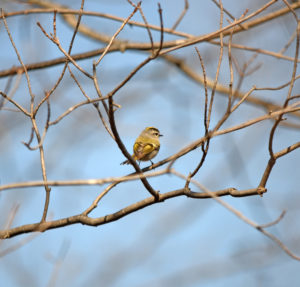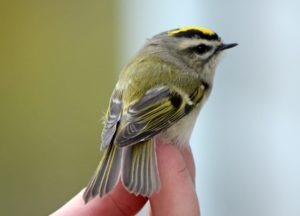
What a beautiful Winter day: cloudless azure skies, temperatures below freezing, and an inch of new snow. A great day for a walk. In an attempt to maintain some semblance of “shape” (not the round kind) I have been doing a lot of long bird walks. Today I decided to walk the Chippawa Trail from Caledonia to the Mountain Brow in Hamilton, a distance of about 20 kilometers. So….I did.
As I wandered along I fell into a reverie stimulated by the conditions: years ago (too many years ago) I had been skiing along a pristine trail in Algonquin Park in fresh powder snow with the temperature at around -15 C. despite the early morning sunshine. At a sharp bend in the trail, there was a dirt embankment about 5 feet high which cut under the vegetation above it; probably caused by whatever machinery had been used to cut the trail initially. I stopped to take a look underneath the overhang and, much to my surprise, found two little feathered balls sitting side-by-side on some roots penetrating through from above. Golden-crowned Kinglets. Their eyes were closed and I saw no movement; I figured they were dead, killed by the -20 C. temperatures during the night. So I continued skiing. But as I walked along today I thought…hmmm….maybe I had been wrong. Maybe this was “torpor” and the birds had simply not warmed up sufficiently yet to stir or show signs of life.
Due to their small size Golden-crowned Kinglets dissipate heat faster than larger birds (having to do with the ratio of body area to mass). To maintain their body temperature of around 43 C. (which is a couple of degrees higher than most birds) it is estimated that they must take in two to three times their body weight in food each day. These kinglets are carnivores, they eat insects. You won’t see them at feeders, even suet feeders which you think would be a good idea for them as fat has a lot of calories. They move quickly through trees and bushes gleaning whatever they can find: in the Winter, dormant insects, clusters of insect eggs, caterpillars that spend the Winter on conifer needles and twig ends. Their rate of foraging is about twice as fast as that of warblers. At this rate it is estimated that they put on two times more fat in a day than another cold-weather resident, the Black-capped Chickadee.

But what about at night? If it’s not eating how does it maintain its temperature? Bernd Heinrich, a professor at the University of Vermont who has studied the species extensively, states: “…how…[it] could survive through a cold, 16-hour long winter night is an unimaginable marvel from our human perspective – it defies physics and physiology.” So how does it get through these cold nights? No one seems to know for sure but there are three possible explanations: 1) the birds find a very sheltered roost out of the weather (wind and snow) and fluff out their feathers for maximum insulation; 2) possibly coupled with 1, the birds huddle together to share body heat; 3) birds enter a state of torpor whereby their body temperature is allowed to go down to a certain threshold, thus reducing their energy requirements. As I mentioned, no one has a clear answer for what they do.
The two birds in question were certainly in a protected spot from the weather; further, the overhang was situated so that it would receive the morning sun and heat up – the heat being captured underneath it. Although they were close together, they weren’t touching and I don’t know how effective closeness without contact is in this situation. The birds appeared to be dormant – was this death or torpor? I wish I had spent more time sorting this out…..
Thinking through this conundrum certainly helped me eat up a few kilometers.
Rick
